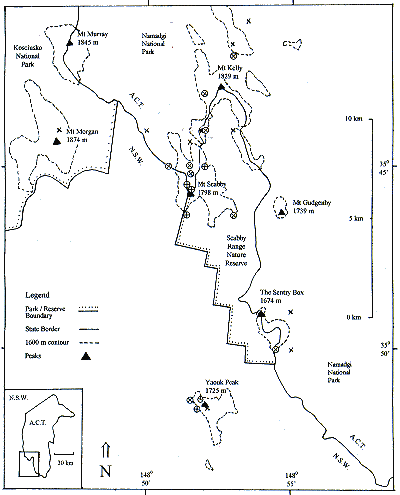|
Australian National Herbarium
|
| Species | Local Frequency |
Species | Local Frequency |
|---|---|---|---|
| Cryptogams: | Myrtaceae | ||
| Cladonia sp. | O | Eucalyptus debeuzevillei Maiden* | U |
| Filicopsida: | E. pauciflora Sieber ex Spreng. | F | |
| Aspleniaceae | Kunzea ericoides (A.Rich.) J.Thompson | R | |
| Asplenium flabellifolium Cav. | R | K. muelleri Benth. | F |
| Dryopteridaceae | Leptospermum micromyrtus Miq. | F | |
| Polystichum proliferum (R. Br.) Presl | R | L. namadgiensis Lyne | F |
| Magnoliopsida-Magnoliideae: | Proteaceae | ||
| Asteraceae | Grevillea lanigera Cunn. ex R. Br. | O | |
| Celmisia sp. nov. a | O | Hakea lissosperma R. Br. | O |
| C. sp. nov. b | F | Rutaceae | |
| Lagenifera stipitata subsp. stipitata (Labill.) Druce | O | Phebalium squamulosum subsp. ozothamnoides (F. Muell.) Paul G. Wilson | R |
| Olearia rhizomatica Lander ms | O | Scrophulariaceae | |
| Ozothamnus thyrsoideus DC. | R | Derwentia perfoliata (R. Br.) B. Briggs & Ehrend. | F |
| Campanulaceae | |||
| Pratia puberula Benth. | O | Thymelaeaceae | |
| Caryophyllaceae | Pimelea linifolia subsp. linifolia Smith | O | |
| Stellaria pungens Brongn. | F | Violaceae | |
| Clusiaceae | Viola betonicifolia subsp. betonicifolia Smith | O | |
| Hypericum japonicum Thunb. | O | Magnoliopsida - Liliideae: | |
| Euphorbiaceae | Anthericaceae | ||
| Poranthera microphylia Brongn. | O | Arthropodium milleflorum (DC.) J.F. Macbr. | O |
| Geraniaceae | |||
| Geranium antrorsum Carolin | R | Juncaceae | |
| Goodeniaceae | Luzula flaccida (Buchenau) Edgar | O | |
| Goodenia hederacea subsp. alpestris (K. Krause) Carolin | F | Orchidaceae | |
| Fabaceae | Chilogiottis valida D.L. Jones | U | |
| Acacia alpina F. Muell. | F | Poaceae | |
| Oxylobium alpestre F Muell. | F | Poa labillardieri var. labillardieri Steud. | F |
| Oxylobium ellipticum (Labill.) R. Br.* | O | Deyeuxia monticola var. monticola (Roem. & Shult.) Vickery | R |
| Lamiaceae | |||
| Westringia lucida B. Boivin | O |
Discussion
Yaouk Peak vegetation can be described as a mixture of predominantly subalpine (sensu Thompson 1981) and rocky heath species (sensu Helman & Gilmour 1985).BIOCLIM generates climate estimates based on meteorological data and topographical information (Busby 1991). User input of the distribution of taxa is used to create climatic profiles, which can subsequently allow predictions of further distributions of these taxa (Busby 1991). BIOCLIM requires precipitation and temperature information, but does not take substrate into account. Leptospermum namadgiensis has only been found on a limited number of substrates, namely porphyritic and muscovitic leucogranite (Yaouk Peak), undifferentiated leucogranite (Scabby Range) and granodiorite (The Sentry Box and Mt Namadgi). As L. namadgiensis has not been found on nearby peaks of similar climate and altitude (Mt Morgan-as predicted by BIOCLIM), it appears that L. namadgiensis may be restricted to certain substrates. Further experimentation would be needed to properly test this hypothesis.

Fig. 1. Distribution of Leptospermum namadgiensis Lyne O
and Olearia rhizomatica Lander ms X
Olearia rhizomatica is found on the same substrates as Leptospermum namadgiensis but in addition it is found on Mt Morgan (adamellite and granodiorite). Olearia rhizomatica appears not to be as restricted by substrate as L. namadgiensis.
Conservation implications
Leptospermum namadgiensis is known from populations within Namadgi National Park and Scabby Range Nature Reserve. Lyne (1993) considered that a conservation code of 2RCat was appropriate for this taxon according to the criteria outlined by Briggs & Leigh (1996). As Yaouk Peak does not lie within a conservation reserve, this code should be amended to 2RCa.Olearia rhizomatica has been recorded from Namadgi and Kosciuszko National Parks, and Scabby Range Nature Reserve. Olearia rhizomatica is listed by Briggs & Leigh (1996) and has been given a conservation code of 2RCit. Again, this should be amended to 2RCi. The citation of 0. rhizomatica in the Tinderry Nature Reserve (Briggs & Leigh 1996) is incorrect, as the specimen from there is not conspecific (I.R. Telford pers. comm.) The populations of Leptospermum namadgiensis and Olearia rhizomatica on Yaouk Peak do not appear to be threatened, as the area is unsuitable for agricultural purposes.
Acknowledgments
I would like to thank the following organisations and people: the Centre for Plant Biodiversity Research (CPBR) for the opportunities provided by the Botanical Internship Programme; H. Hewson, I. Telford, A. Lyne and J. Palmer for their help, time and patience; P. Hohnen and S. York for their help with database queries; CBG for the use of their library; the administration staff at the Herbarium for use of their computer; and M. Henwood (SYD) for his assistance with the final drafts.
References
Briggs, J.D. & Leigh J.H. (1996) Rare or threatened Australian plants. CSIRO, Canberra.Busby, J.R. (1991) BIOCLIM - A bioclimatic analysis and prediction system. In: Margules, C.R. & Austin, M.P. (eds.), Nature conservation: cost effective biolgical surveys and data analysis. CSIRO, Australia.
Helman, C.E. & Gilmour, P.M. (1985) Treeless vegetation above 1000 metres altitude in the A.C.T. Conservation Council, Canberra.
Lyne, A.M. (1993) Leptospermum namadgiensis (Myrtaceae), a new species from the Australian Capital Territory-New South Wales border area. Telopea 5 (2): 319-324.
Snelling, N.J. (1960) The geology and petrology of the Murrumbidgee batholith. The Quarterly Journal of the Geological Society of London 116 (2): 187-217.
Thompson, J. (1981) A key to the plants of the subalpine and alpine zones of the Kosciusko region. Telopea 2 (3): 219-297.
Student Botanical Internship Program
Publications Page
Placed here by Andrew Lyne (al@anbg.gov.au)